Abstract
The regional deposition of a monodisperse 10-micron mass median aerodynamic diameter fog was studied in four healthy adult male nonsmokers. The fog was radiolabeled with technetium-99m sulfur colloid to enable detection by an Anger camera of deposited activity in the following regions of the respiratory tract: oropharynx, larynx, trachea, and intrapulmonary airways. Intrapulmonary deposition was further analyzed by computer with inner, intermediate, and outer zones, and within apical, intermediate and basal zones of the right lung. The radiolabeled aerosol was inhaled by mouth through a face-mask with the nasal airway occluded. Respiratory frequency, tidal volume, and jaw position were controlled and were commensurate with the oral component of oronasal breathing during moderate exercise. Deposition in the larynx, trachea, and intrapulmonary airways was a function of the scrubbing efficiency of the oropharynx, which differed substantially among subjects, and ranged from 72 to 99%. The density of the aerosol deposit in the larynx probably exceeded that of any of the subdivisions of the tracheobronchial tree and lung. Within the lung, deposition favored the inner zone (assumed to contain the larger airways) over the outer zone (assumed to be dominated by smaller airways and alveoli). Intrapulmonary aerosol distribution in an elderly subject with borderline evidence of airway obstruction differed from that observed in younger subjects. The possible consequences of altered lung elastic recoil, as may occur with aging, for regional dosimetry is discussed.
Full text
PDF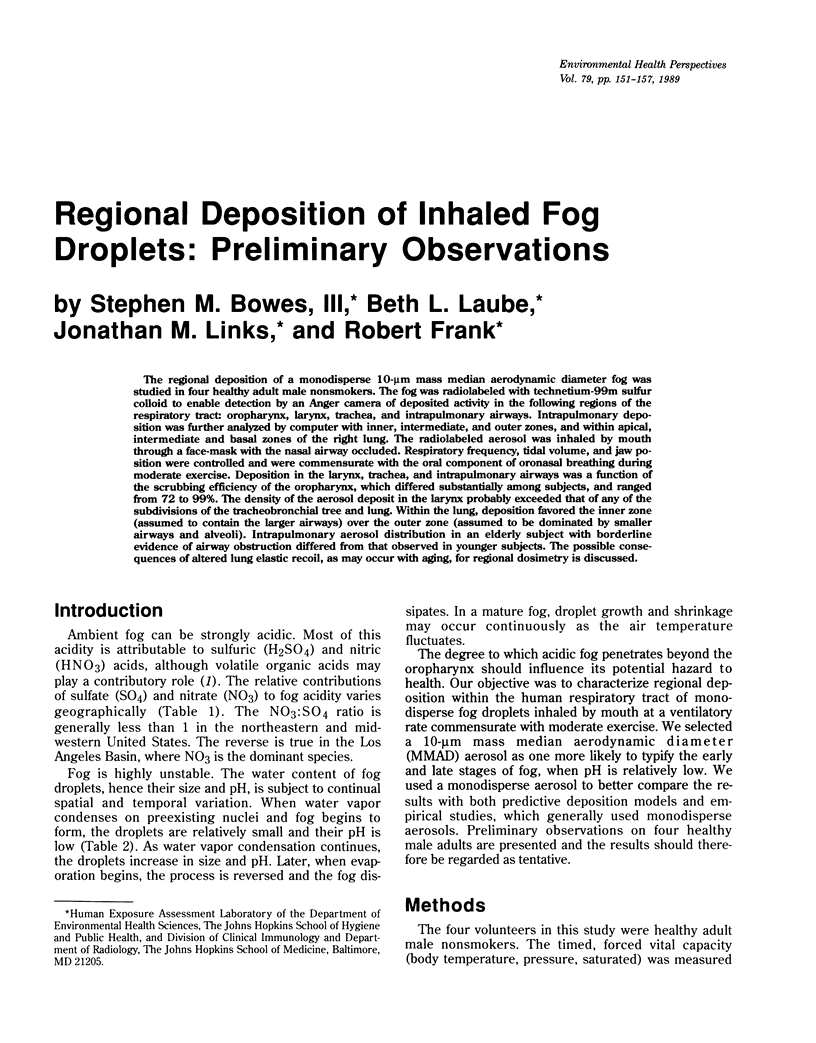
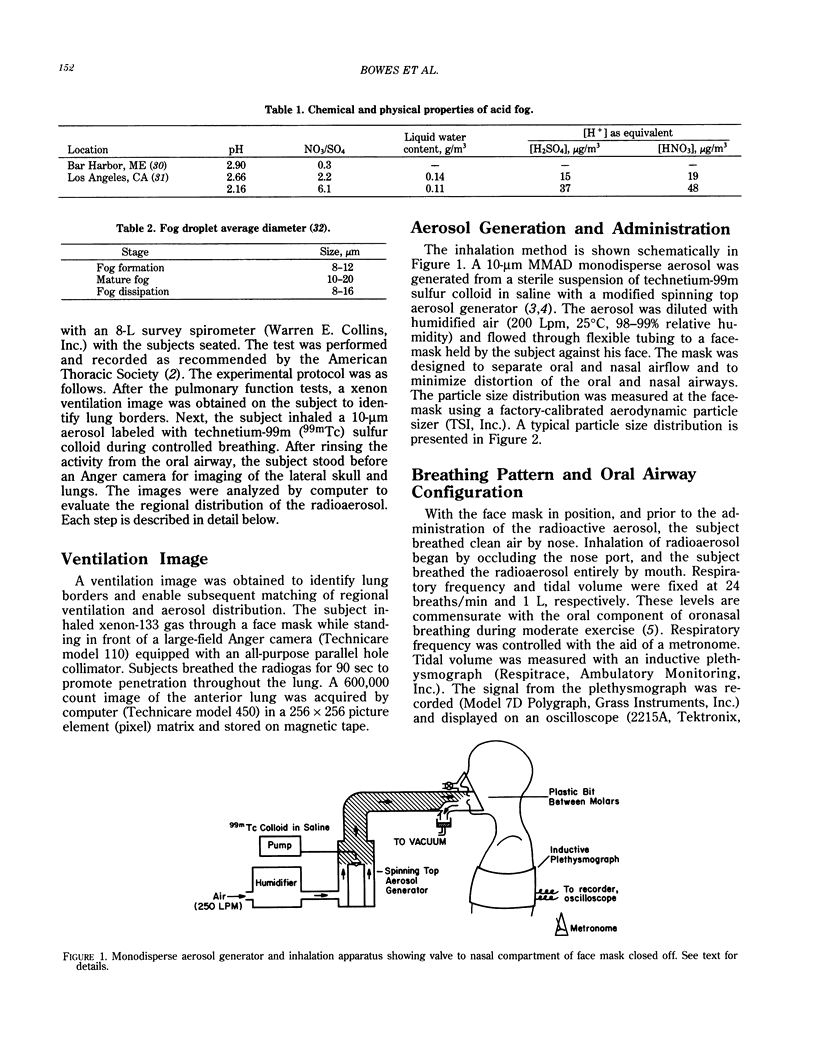
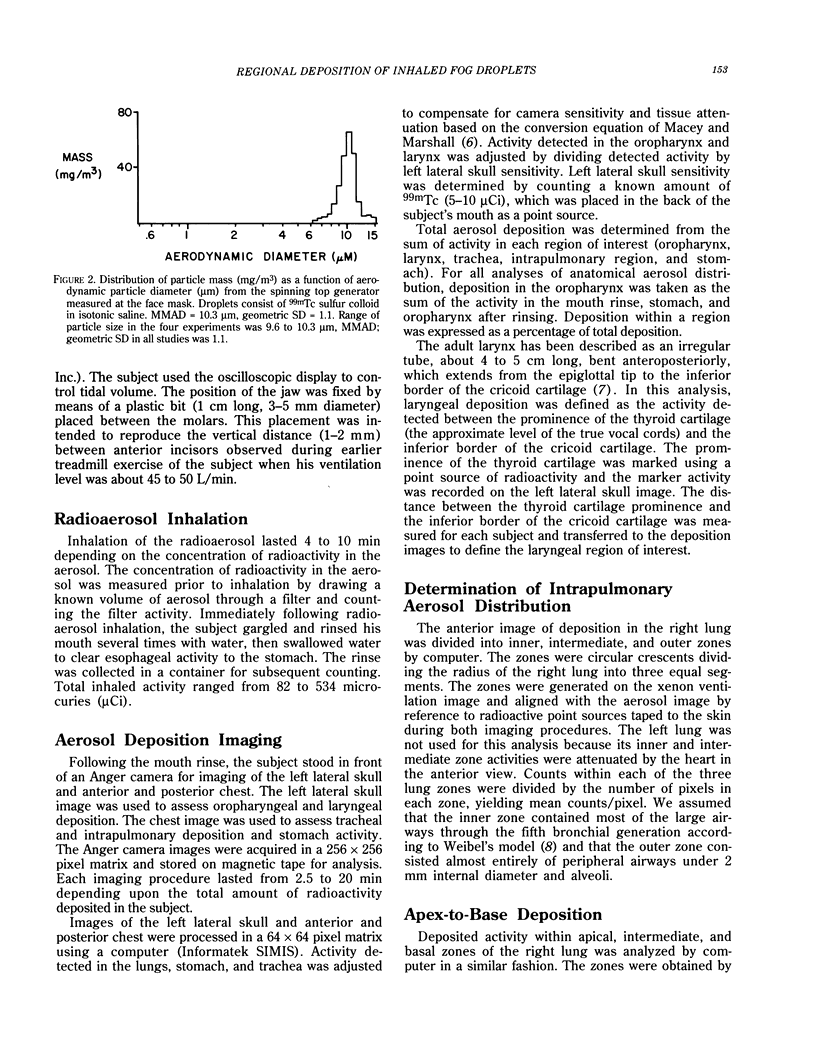
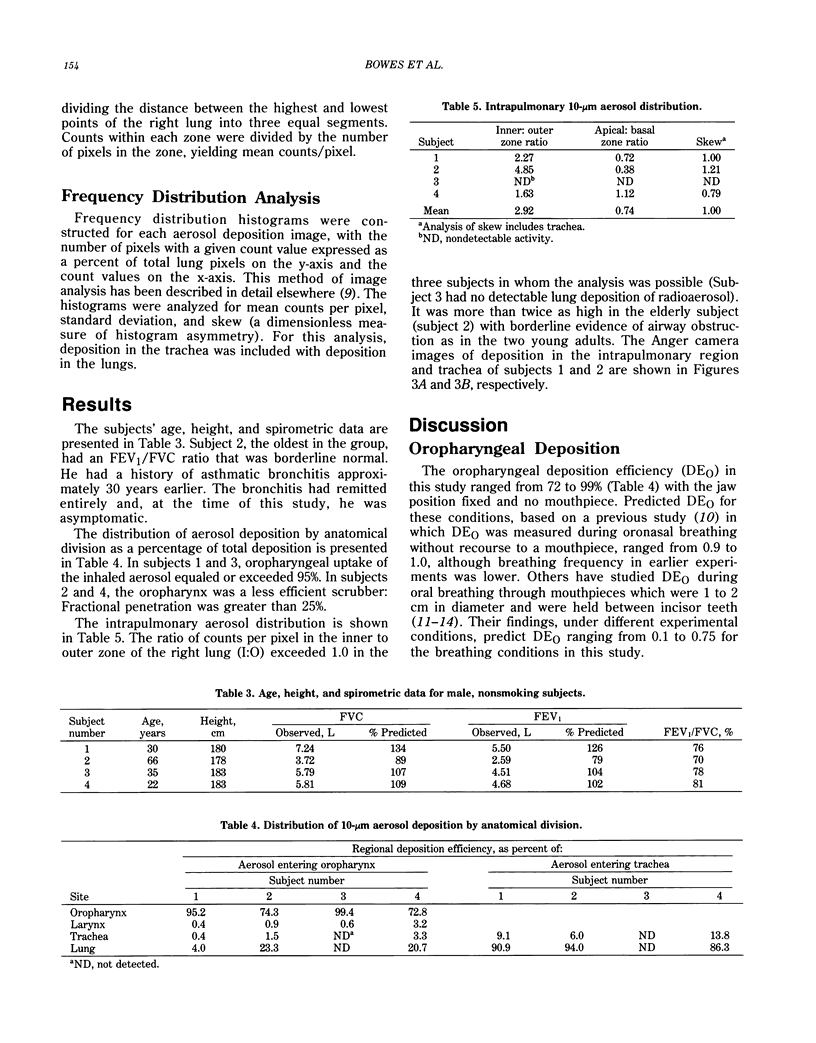
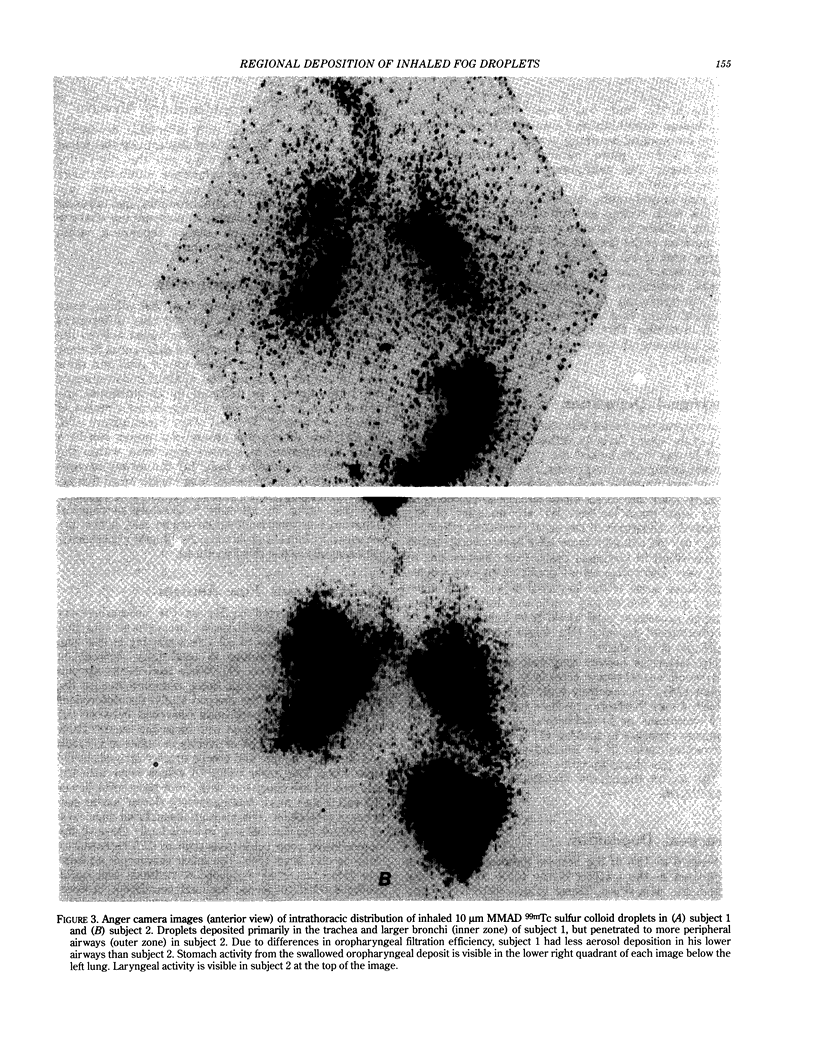
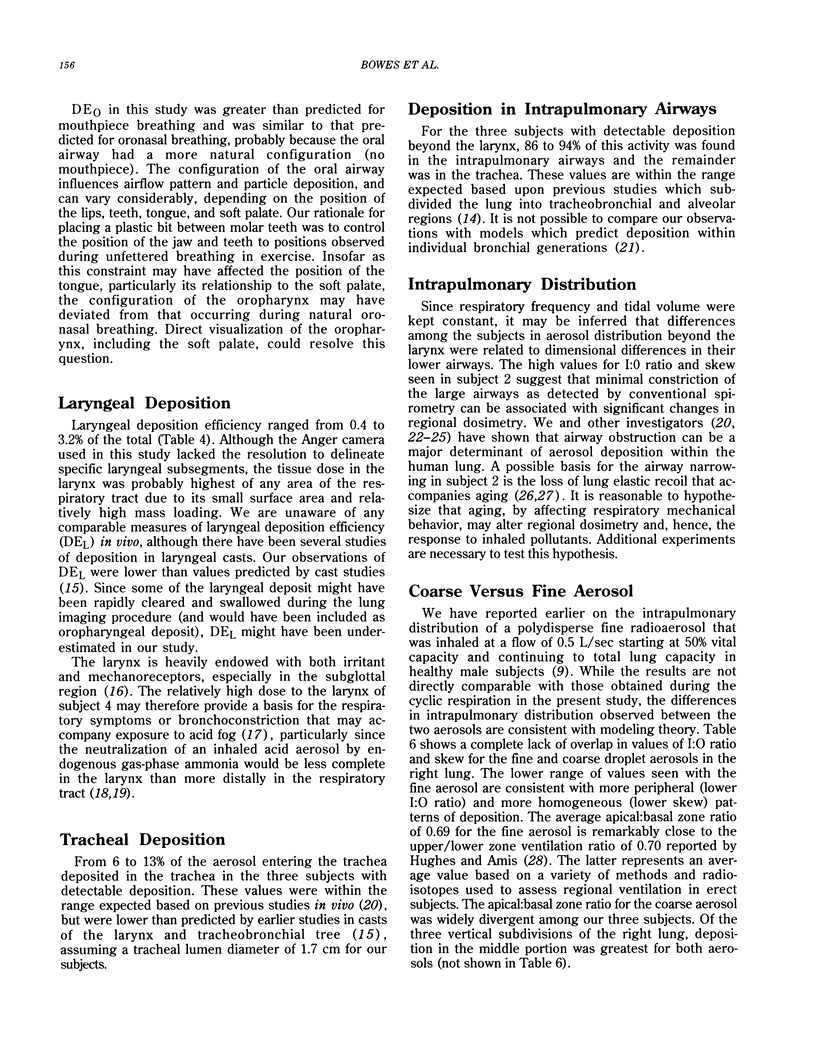
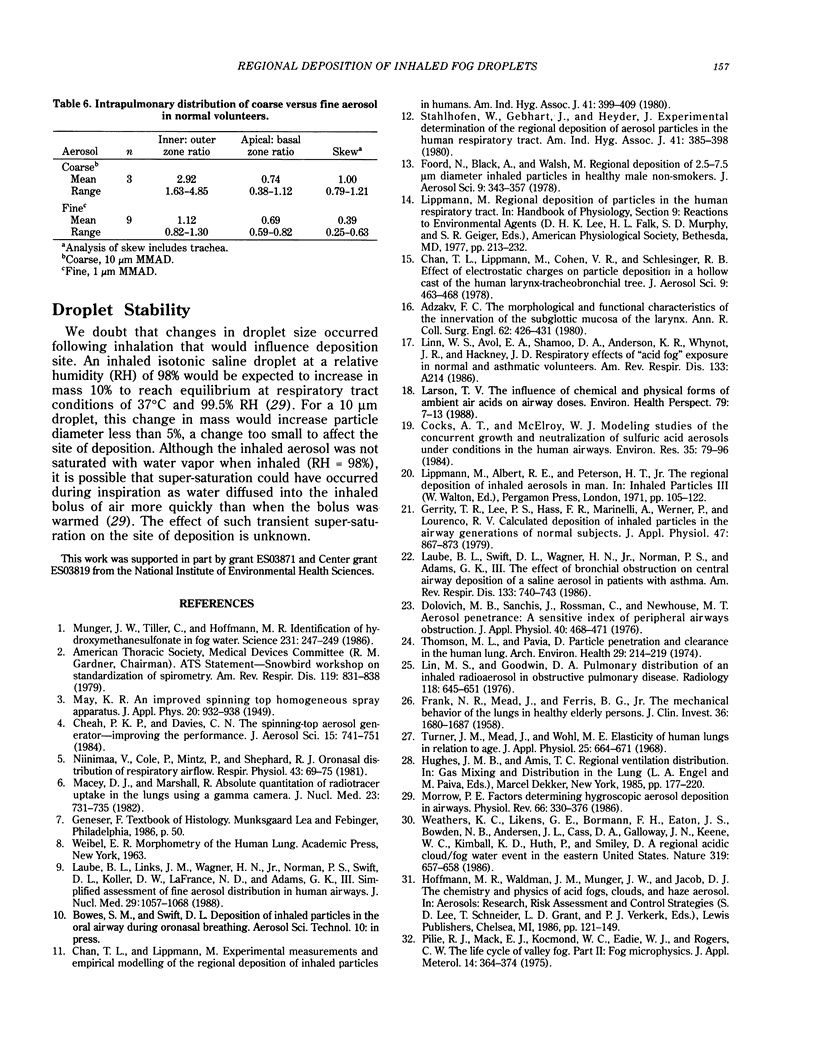
Images in this article
Selected References
These references are in PubMed. This may not be the complete list of references from this article.
- Adzaku F. K. The morphological and functional characteristics of the innervation of the subglottic mucosa of the larynx. Ann R Coll Surg Engl. 1980 Nov;62(6):426–431. [PMC free article] [PubMed] [Google Scholar]
- Chan T. L., Lippmann M. Experimental measurements and empirical modelling of the regional deposition of inhaled particles in humans. Am Ind Hyg Assoc J. 1980 Jun;41(6):399–409. doi: 10.1080/15298668091424942. [DOI] [PubMed] [Google Scholar]
- Cocks A. T., McElroy W. J. Modeling studies of the concurrent growth and neutralization of sulfuric acid aerosols under conditions in the human airways. Environ Res. 1984 Oct;35(1):79–96. doi: 10.1016/0013-9351(84)90115-4. [DOI] [PubMed] [Google Scholar]
- Dolovich M. B., Sanchis J., Rossman C., Newhouse M. T. Aerosol penetrance: a sensitive index of peripheral airways obstruction. J Appl Physiol. 1976 Mar;40(3):468–471. doi: 10.1152/jappl.1976.40.3.468. [DOI] [PubMed] [Google Scholar]
- FRANK N. R., MEAD J., FERRIS B. G., Jr The mechanical behavior of the lungs in healthy elderly persons. J Clin Invest. 1957 Dec;36(12):1680–1687. doi: 10.1172/JCI103569. [DOI] [PMC free article] [PubMed] [Google Scholar]
- Gerrity T. R., Lee P. S., Hass F. J., Marinelli A., Werner P., Lourenço R. V. Calculated deposition of inhaled particles in the airway generations of normal subjects. J Appl Physiol Respir Environ Exerc Physiol. 1979 Oct;47(4):867–873. doi: 10.1152/jappl.1979.47.4.867. [DOI] [PubMed] [Google Scholar]
- Larson T. V. The influence of chemical and physical forms of ambient air acids on airway doses. Environ Health Perspect. 1989 Feb;79:7–13. doi: 10.1289/ehp.89797. [DOI] [PMC free article] [PubMed] [Google Scholar]
- Laube B. L., Links J. M., Wagner H. N., Jr, Norman P. S., Koller D. W., LaFrance N. D., Adams G. K., 3rd Simplified assessment of fine aerosol distribution in human airways. J Nucl Med. 1988 Jun;29(6):1057–1065. [PubMed] [Google Scholar]
- Laube B. L., Swift D. L., Wagner H. N., Jr, Norman P. S., Adams G. K., 3rd The effect of bronchial obstruction on central airway deposition of a saline aerosol in patients with asthma. Am Rev Respir Dis. 1986 May;133(5):740–743. doi: 10.1164/arrd.1986.133.5.740. [DOI] [PubMed] [Google Scholar]
- Lin M. S., Goodwin D. A. Pulmonary distribution of an inhaled radioaerosol in obstructive pulmonary disease. Radiology. 1976 Mar;118(3):645–651. doi: 10.1148/118.3.645. [DOI] [PubMed] [Google Scholar]
- Macey D. J., Marshall R. Absolute quantitation of radiotracer uptake in the lungs using a gamma camera. J Nucl Med. 1982 Aug;23(8):731–734. [PubMed] [Google Scholar]
- Morrow P. E. Factors determining hygroscopic aerosol deposition in airways. Physiol Rev. 1986 Apr;66(2):330–376. doi: 10.1152/physrev.1986.66.2.330. [DOI] [PubMed] [Google Scholar]
- Munger J. W., Tiller C., Hoffmann M. R. Identification of hydroxymethanesulfonate in fog water. Science. 1986 Jan 17;231(4735):247–249. doi: 10.1126/science.231.4735.247. [DOI] [PubMed] [Google Scholar]
- Niinimaa V., Cole P., Mintz S., Shephard R. J. Oronasal distribution of respiratory airflow. Respir Physiol. 1981 Jan;43(1):69–75. doi: 10.1016/0034-5687(81)90089-x. [DOI] [PubMed] [Google Scholar]
- Stahlhofen W., Gebhart J., Heyder J. Experimental determination of the regional deposition of aerosol particles in the human respiratory tract. Am Ind Hyg Assoc J. 1980 Jun;41(6):385–98a. doi: 10.1080/15298668091424933. [DOI] [PubMed] [Google Scholar]
- Thomson M. L., Pavia D. Particle penetration and clearance in the human lung. Results in healthy subjects and subjects with chronic bronchitis. Arch Environ Health. 1974 Oct;29(4):214–219. doi: 10.1080/00039896.1974.10666571. [DOI] [PubMed] [Google Scholar]
- Turner J. M., Mead J., Wohl M. E. Elasticity of human lungs in relation to age. J Appl Physiol. 1968 Dec;25(6):664–671. doi: 10.1152/jappl.1968.25.6.664. [DOI] [PubMed] [Google Scholar]




